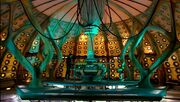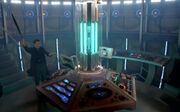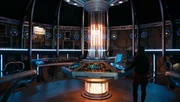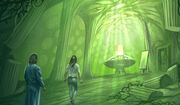A TARDIS control room was any place on a TARDIS that contained a working control console. They also functioned as a point of exit. If the Doctor, the Master, the Monk and the Rani's TARDISes were any indication, control rooms featured relatively open floor plans, in which the control console was vaguely, but rarely precisely, in the middle of the room. Control rooms, interchangeably called console rooms, also usually contained walls with roundels, scanners for viewing the TARDIS exterior, and fairly sparse furnishings. For example, no known TARDIS control room allowed for the operation of the console itself from a seated position.
Other than those generalisations, the shape, size and ambience of a control room, even within just the Doctor's TARDIS, was highly variable.
A control room's look could be changed over time. The process by which an operator could transform a control room was fairly simple, once compared by the Fifth Doctor to changing a "desktop theme". (TV: Time Crash) On some occasions, a TARDIS managed the change itself. Once, the Doctor regenerated with extreme violence, destroying much of his control room; the TARDIS was able to completely redesign its interior and console room without the Doctor's assistance. (TV: The Eleventh Hour)
By the time of his eleventh incarnation, the Doctor's console room had gone through at least twelve redesigns, though the TARDIS revealed that she had archived 30 versions. Once a control room was reconfigured, the TARDIS archived the old design "for neatness". The TARDIS effectively "curated" a museum of control rooms — both those in the Doctor's personal past and future. (TV: The Doctor's Wife)
The Doctor's console room
Simply white

The Eleventh Doctor enters the original TARDIS control room. (COMIC: Hunters of the Burning Stone)
When the interior of the TARDIS was first seen by Ian Chesterton and Barbara Wright, it was a bright white room, with roundels on the walls and a large computer bank taking up a major part of the 'back' wall. These computer banks contained the fault locator and various systems relating to navigational control. (TV: An Unearthly Child, The Daleks) This console was removed by the Third Doctor during his exile on Earth for use in his laboratory. He hoped he would be able to bypass the limitations that the Time Lords had placed on his ability to control the TARDIS by removing the console from the TARDIS itself. However, not only did he require a significant amount of power to make the TARDIS move more than a few seconds in time and a few hundred metres in space, he also removed so many security protocols that he travelled sideways in time into a parallel universe, where he was nearly killed before he managed to convince the alternate versions of his friends to help him return home. (TV: Inferno) The Doctor returned it to its old place later. (TV: Terror of the Autons)
The Doctor continued to rebuild the TARDIS console and the main interior of the TARDIS console room using "UNIT funds and equipment" throughout his exile as UNIT's scientific adviser, in hopes of eventually escaping Earth to continue his travels. (TV: The Three Doctors)
The Doctor briefly changed the walls of the console room, replacing the cylindrical roundels with bowl-shaped ones that jutted outwards. One of the roundels served as a replacement for the scanner, a picture appearing in its centre. (TV: The Time Monster) He later reverted to the more traditional design, though one wall still contained the bowl-roundels. (TV: The Three Doctors)
The Fifth Doctor rebuilt the console following damage done to it by a stray shot from a Cyberman's gun meant for him. (TV: Earthshock) On orders from the Black Guardian, Vislor Turlough later damaged the Heart of the TARDIS enough to the point of the TARDIS nearly falling apart (TV: Terminus), leaving the room darker for some time until repairs were done. (TV: Enlightenment) The Doctor's fifth incarnation later refurbished it completely, giving it a sleeker, more high-tech appearance. The monitor in this version opened in a similar fashion to an eye; it rested between the exit and the door leading further in. In comparison to the control rooms that his earlier incarnations used, the Fifth Doctor's was more metallic grey than white. (TV: The Five Doctors) It would be used by his next two following incarnations (the Sixth and Seventh Doctors), (TV: The Twin Dilemma - Survival) following his regeneration (TV: The Caves of Androzani).
The console in this room was duplicated by a matter-manipulating entity that the Rani had enslaved to do her bidding, seeking to replace the console room of her own TARDIS after the Tremas Master had separated it from the rest of her ship to save himself from a tyrannosaurus rex. (TV: The Mark of the Rani) For a time, this console was used as an Oracle by the population of Alexandria in a duplicated version of Ancient Egypt that the entity had created by accident. The people accessed its databanks to learn about future technology. The duplicate console was eventually connected to the Rani's TARDIS, allowing her to control her ship once again. (PROSE: State of Change)
Second control room

The Doctor and Sarah escape the Mandragora Helix - Doctor Who - BBC
The Fourth Doctor and Sarah in the second control room. (TV: The Masque of Mandragora)
There existed a small second control room which the Doctor claimed may have been the original console room; a recorder and smoking jacket were found in here, implying both the Second and Third Doctors visited this room but chose not to use it. It was simpler and more compact than the main control room, with the console resembling a desk, no visible time rotor and all the controls hidden behind what appeared to be wooden panelling. It had more subtle roundels, some of them framing stained glass windows. For a brief period, the Fourth Doctor used this as the main control room. (TV: The Masque of Mandragora, The Hand of Fear, The Deadly Assassin, The Robots of Death, The Invisible Enemy)
While looking for a Kymbra Chimera which had invaded the TARDIS, the Sixth Doctor and Frobisher discovered it and Peri in the second control room. (COMIC: Changes)
At least one second control room was lost when the Seventh Doctor ejected the primary one from the TARDIS in an attempt to defeat Qataka, a megalomaniac who had downloaded her mind into the TARDIS, the Doctor having tricked her into thinking that the TARDIS life support systems were controlled from that console. However, Qataka was able to use the console to turn herself into the godlike Timewyrm. (PROSE: Timewyrm: Genesys, Timewyrm: Revelation)
At one stage, the Seventh Doctor suspected that the secondary control room had been deleted, as he hadn't seen it in a while. (PROSE: Cat's Cradle: Time's Crucible)
Victorian parlour

Eighth Doctor's control room. (TV: Doctor Who)
At some point the Seventh Doctor began to use a control room that resembled a comfortable Victorian parlour. This design was inherited by the Eighth Doctor. (TV: Doctor Who) River Song was known to have loved this version of the room, (GAME: The Eternity Clock) while the Fourth Doctor and Charley Pollard found it in poor taste. (AUDIO: The Light at the End, The Stones of Venice) After later consoles, The Eighth Doctor would later restore, or copy this console. (COMIC: The Land of Happy Endings)
Description
Its comparatively vast interior was significantly larger than any that had come before or after. In this version, the console itself was not the central focus of the room, but merely one of its many features. A vast bureau almost entirely covered one wall, its huge drawers filled with various objects the Doctor wished to retain. Surrounding the console itself were several metal half-arches, covered in circular holes resembling roundels. Clocks of all description — but mostly mechanical ones — littered various nooks and crannies. Far from the evenly lit, mostly white interior of the past, this control room had multiple light sources and an abundance of wooden surfaces, which allowed the Doctor to create a sense of warmth and even opulent comfort. At least a portion of the Doctor's books were in another alcove, forming a sort of en suite library. (TV: Doctor Who)
Furniture, usually anathema to the Doctor's control rooms, was found in abundance here. Indeed, there was a large area immediately adjacent larger than the console area itself, which had several comfortable chairs, lamps, an ottoman — all of which conspired to give this control room the appearance of a cosy living room.
Above it all was a scanner the size of the entire ceiling. The Doctor could flip a switch on his console and reveal astronomical phenomena on a grand scale. (PROSE: War of the Daleks)
According to companion Will Arrowsmith, this console room was not "proper Victorian" but "pseudovictorian" and apparently heavily inspired by H. G. Wells' story The Time Machine, though based more upon the movie adaptation rather than the novel itself. (AUDIO: Persuasion)
Origin
Accounts differed wildly over how this version of the control room had been created. Amongst the competing theories were:
- The TARDIS herself changed the room after being trapped inside the Doctor's family estate, the House of Lungbarrow. It rebuilt itself to resemble the house after the Doctor temporarily severed the link between the interior and exterior to prevent his family stealing the ship. After he had restored the TARDIS, the console room retained this homier design (PROSE: Lungbarrow) This theory, however, was fundamentally incompatible with the number of other accounts that depicted the Seventh Doctor in the new console room long before the Lungbarrow incident. (PROSE: Human Nature, COMIC: Ground Zero, AUDIO: Forty-five)
- The Doctor — and not the TARDIS – had simply "built" it. (AUDIO: Excelis Decays)
- It was standard equipment. Merely another secondary console room, it had been there for some time, and was in fact meant to be the main console room all along. (PROSE: The Dying Days)
Edifice
Following the TARDIS' destruction after it was caught in a dimensional tear (PROSE: The Shadows of Avalon), it reconstructed itself into a massive, bone-like structure that came to be known as the Edifice. Its console room at this stage was apparently based on the console room at the time of destruction, but appeared, like the rest of the ship, to be made of bone. This was due to the TARDIS containing the Faction Paradox biodata virus that had infected the Third Doctor after his early regeneration. (PROSE: Interference - Book Two, The Ancestor Cell) The console also manifested an 'avatar' of the Third Doctor composed of the dust in the ship, apparently the manifestation of the Third Doctor who should have existed before the Faction changed his history. This console room was 'destroyed' when the Doctor drained the Edifice of all its power in order to fire the ship's ancient weapon systems, erasing the Dust regeneration from history and forcing the TARDIS to spend the next century repairing itself. (PROSE: The Ancestor Cell)
Later Eighth Doctor
The TARDIS completed its regeneration on Earth, after the Doctor exhausted its power in the destruction of Gallifrey. Its interior now resembled a mixture of the original console room and the library-like room often associated with the Eighth Doctor. (PROSE: Escape Velocity) The console was initially octagonal, (PROSE: The Slow Empire) but was later reconfigured to be pentagonal. (PROSE: Trading Futures) The Control Room was now hexagonal [statement unclear] and contained four alcoves, two on either side of the main doors and the interior door. One contained filing cabinets and chests, another led to the library, the third contained a laboratory, and the fourth contained a kitchen (which looked out onto an English countryside vista and was an exact replica of the kitchen in the Doctor's house in Kent). This interior was destroyed when the Doctor used the TARDIS to contain the explosion of a cold fusion generator created by the TARDIS' original owner. (PROSE: The Gallifrey Chronicles)
War console

The War Doctor's console surrounded by the War, Tenth and Eleventh Doctors plus Clara Oswald. (TV: The Day of the Doctor)
The War Doctor used a control room during the Last Great Time War, this time reminiscent of his first incarnation's control room with similar white walls and roundels, albeit with new coral support beams and a matching console, which incorporated many odds and ends, ranging from a device like a bicycle pump to a mallet used for percussive maintenance. This console was inherited by the Ninth Doctor. The entire room looked as though it had been built from spare parts. Examples could include the wiring and circuitry laid out around the outside of the platform the console was set on, the platform itself was clean and tidy where as everything else was dirty. (TV: The Day of the Doctor)
Coral console

The Tenth Doctor in his "coral" control room. (TV: Doomsday)
Early during the Ninth Doctor's life, the control room had been changed to its "coral" theme. This organic design was similar to its previous iteration used by the War and (briefly) Ninth Doctors during and after the Last Great Time War respectively. However, the walls were now golden, with smaller, hexagonal impressions replacing the white roundels of the previous console room. This iteration of the console had apparently been available as early as the era of the Fifth Doctor, who disliked it, considering it worse than the "leopard skin" version. (TV: Time Crash). This control room was inherited by the Tenth Doctor. (TV: The Parting of the Ways)
The console itself was a more aged version of the previous console. There was a monitor on the console that displayed Gallifreyan writings with sticky notes on it, left by the Doctor. It could also show television channels. (TV: Rose onwards) When Mickey Smith asked Rose Tyler how it worked, Rose said, "It sort of tunes itself." (TV: The Christmas Invasion) It also contained a working telephone, used once by the Doctor. (TV: World War Three) The console room consisted of a circular area, with a red-tiled ramp leading from the doors to a hexagonal platform. On the platform was a second, circular platform. The entire room was supported by six coral pillars arranged in a hexagonal pattern that met with the top of the time rotor at the room's ceiling. There were also several black wires connecting to the time rotor. Under the main platform were storage areas large enough for the Doctor to enter himself to retrieve items (TV: Army of Ghosts), though some were packed to just below the top. (TV: The Unicorn and the Wasp) It was also dim, illuminated by the glow of green light from the time rotor column in the centre of the room and the lights in the hexagons on the walls. (TV: Rose - Doomsday) However, the glow was later made less noticeable as the Doctor used the other lights. (TV: The Runaway Bride - The End of Time)
The console room was set on fire and at least one column destroyed by the Tenth Doctor's violent regeneration into his eleventh incarnation. Much of the wiring in the ceiling fell apart and parts of the console exploded. The damage to the console was extensive enough to cause the Door Release Lever to malfunction. The Doctor nearly fell out of the TARDIS, and to his death (again) because of this. (TV: The End of Time, The Eleventh Hour)
It was rebuilt by the TARDIS, but decided to replace it with the Sixth version. The Eleventh Doctor, Amy Pond, Rory Williams and the separated matrix of the TARDIS entered it when House had control of the TARDIS. House deleted the room for the power needed to leave the bubble universe he was in and enter N-Space. (TV: The Doctor's Wife)
Copper console

Amy Pond and the Eleventh Doctor in the TARDIS console room. (TV: The Eleventh Hour).
Due to the violent nature of the Tenth Doctor's regeneration and the resultant damage to the TARDIS, it required time to repair itself. After the ordeal involving the Atraxi attempting to recapture Prisoner Zero had been resolved, the Doctor returned to the TARDIS and, upon seeing the replacement control room, immediately took the TARDIS to the Moon and back to Earth to "run her in", though accidently travelled forward two years in doing so. Soon after taking Amy Pond on board for the first time, the new TARDIS console also provided the Doctor with a new sonic screwdriver, as the previous one had been destroyed. (TV: The Eleventh Hour)
Changes to the control room included a new hexagonal console with instruments resembling a typewriter, a telegraph, a gramophone, a set of hot and cold taps, and a view-screen made by Magpie Electricals. A larger, circular, secondary view screen was set into one of the walls. (TV: The Beast Below, Victory of the Daleks, The Hungry Earth, Cold Blood, The Girl Who Waited) There were fewer roundels on the walls than in the past, and an area located underneath the main console which housed the Heart of the TARDIS. This version also possessed an actual phone, on which people could call the Doctor. (TV: Victory of the Daleks, The Big Bang, Bad Night) There was also a swing located under the glass floor the Doctor or anyone else could sit on to help with maintainence. (TV: The Vampires of Venice, Amy's Choice, The Pandorica Opens, Space) The railings originally were rectangular barred and black in colour. (TV: The Eleventh Hour) They were later round barred and gold. (TV: A Christmas Carol, et al)
It had at least three floors: a lower section, the console room level, and the second level. (TV: The Eleventh Hour) Unlike its immediate predecessor, this console room had three visible exits to the rest of the TARDIS; two on the lower levels and one via a set of stairs. (TV: The Eleventh Hour - The Angels Take Manhattan)
Neon console

The Eleventh Doctor in his new console room. (TV: The Snowmen)
At some point after his separation from the Ponds, the Eleventh Doctor dispensed with the whimsical control room when his personality turned less jovial. Seemingly smaller, his new control room contained a console with more literal input devices and instrumentation. The room was stark and mechanical, covered in tones of teal and aqua, and an overall cold mood to reflect a more depressive Doctor. (TV: The Snowmen onwards)

Clara Oswald assesses the Twelfth Doctor's redecoration of the console room. (TV: Deep Breath)
This control room was inherited by the Twelfth Doctor. (TV: The Time of the Doctor), who proceeded to upgrade the console room by adding several items to it, including a reclining chair, bookshelves, candles, chalkboards, an additional staircase to the upper level and circular lights around the lower balcony. He also changed the lighting of the time rotor and room from its original aqua to orange, creating an ambient glow that added warmth to the room. Overall, he gave the once empty and stark control room a homelike sense of decor, provision, and sophistication. (TV: Deep Breath)
The control room that Clara knew featured aqua/orange lighting and time rotor, blue Gallifreyan markings on the ceiling and above the time rotor, hexagonal roundels on the lower console level, and Gallifreyan markings on the top level. Several tiny lights went around the walls of the room in a straight line, flashing sections at a time. The console featured two screens, and what seemed to be a radar on one face. There were two additional consoles around the edge of the main level. It was also much darker than the previous iteration. Except for the time rotor, all lights could be turned off when the Doctor was not inside.
There were three levels: an upper balcony, which looked down over the console and had doorways off of it, the landing, which housed the console, seating, and main doors (TV: The Snowmen) and the lower level, which had several compartments one of which contained clothing. The Eleventh Doctor assembled his new attire from the clothes held in this compartment. (TV: The Bells of Saint John) There were three doorways to other sections of the TARDIS, two on the upper level either side of the main doors, and two on the lower level. One of the compartments under the console contained a ladder leading to a lower part of the TARDIS whilst one of the roundels on the lower section of the wall opened to reveal a passageway that led to the engine room at the centre of the TARDIS. (TV: Journey to the Centre of the TARDIS)
This console room however lacked a hat stand, a factor which even the Doctor hadn't noticed until asked about it by Clara. (TV: Hide) The Twelfth Doctor's redecorated console room once more included the hat stand, located on the lower level. (TV: Mummy on the Orient Express)
Other control rooms

The Tertiary console room. (PROSE: Nightshade)
There also existed a tertiary control room, which was cool and dark grey with a small mushroom-shaped console. (PROSE: Nightshade, Sanctuary)
Soon after the TARDIS became infected by an organic material from Tír na n-Óg, (PROSE: Cat's Cradle: Witch Mark) the Doctor began adapting the Zero Room into another console room, disconnected from the Universe, so he could escape the effects. This control room/zero room was lost when the Seventh Doctor ejected it from the TARDIS in an attempt to destroy the sentient computer, Pool. (PROSE: Deceit)
During his tenth incarnation, the Doctor claimed that all previous console rooms remained within the TARDIS, waiting to be reused, much as the secondary control room had been accidentally rediscovered by him during his fourth incarnation. He further intimated that there may have been even more control rooms than were known to have been used. (COMIC: Tesseract)
As Idris, the TARDIS told the the Eleventh Doctor it had so far archived thirty control rooms. The Doctor argued he had only changed the desktop theme a dozen times and it couldn't archive things that hadn't happened yet. The TARDIS merely replied that he couldn't. (TV: The Doctor's Wife)
Behind the scenes
- The Victorian parlour console is the first to have the time rotor connected to the roof. (Doctor Who onward)
- The Copper console room is the first to have several levels, and more than 2 exit doors. (The Eleventh Hour onward)
- Every TARDIS console room has contained a coat rack or umbrella stand, except for the neon console. (The Snowmen to The Time of the Doctor) This was rectified by at least Mummy on the Orient Express.
- Every console room that the TARDIS has had, bore circles and/or hexagonal panels on the wall.
- There have only been a couple of storylines in which more than one version of the TARDIS console room have been featured. Technically, the first would have been TV: The Two Doctors, had the same TARDIS set not been simply reused for both the Second and Sixth Doctor's TARDIS. The first true case of more than one different TARDIS set being used in a single story was TV: The Eleventh Hour in which the console room for the Ninth/Tenth Doctors appears in the opening scene, with the first Eleventh Doctor room is introduced in the finale. The two sets also share an episode in The Doctor's Wife, and again in The Day of the Doctor, except joined by a third TARDIS console room set, for the War Doctor. The console rooms used by the First to Eighth Doctors can be seen on the screens connecting them to the War Council.
